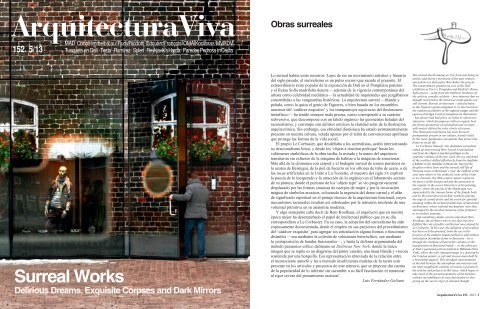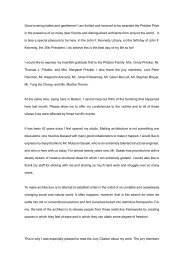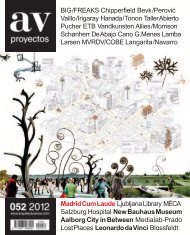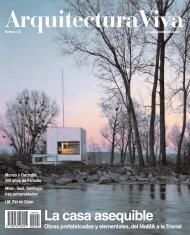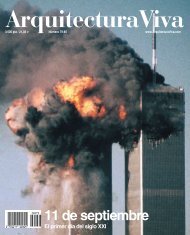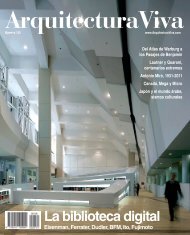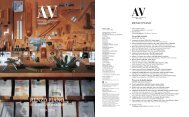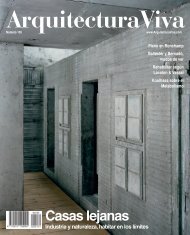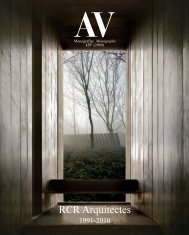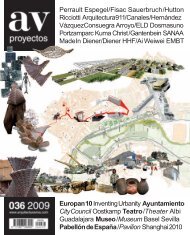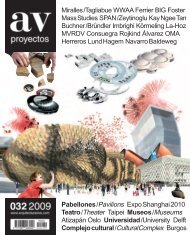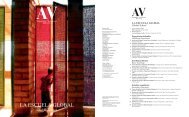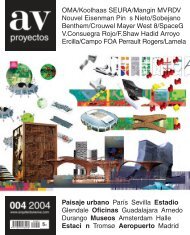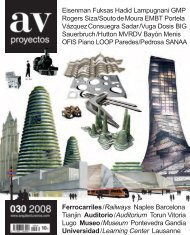Surreal Works - Arquitectura Viva
Surreal Works - Arquitectura Viva
Surreal Works - Arquitectura Viva
You also want an ePaper? Increase the reach of your titles
YUMPU automatically turns print PDFs into web optimized ePapers that Google loves.
<strong>Arquitectura</strong><strong>Viva</strong><br />
Obras surreales<br />
152. 5/13<br />
MAD · Coop Himmelb(l)au · Rudy Ricciotti · Édouard François · OMA/Koolhaas· MVRDV<br />
Tusquets on Dalí · Testa · Ramírez · Soleri · Reykjavik’s Harpa · Paredes Pedrosa in Ceuta<br />
<strong>Surreal</strong> <strong>Works</strong><br />
Delirious Dreams, Exquisite Corpses and Dark Mirrors<br />
Lo surreal habita entre nosotros. Lejos de ser un movimiento artístico y literario<br />
del siglo pasado, el surrealismo es un pulso oscuro que sacude el presente. El<br />
extraordinario éxito popular de la exposición de Dalí en el Pompidou parisino<br />
y el Reina Sofía madrileño denota —además de la vigencia contemporánea del<br />
artista como celebridad mediática— la actualidad de inquietudes que juzgábamos<br />
constreñidas a las vanguardias históricas. La arquitectura surreal —blanda y<br />
peluda, como la quiso el genio de Figueres, o bien basada en los ensambles<br />
azarosos del ‘cadáver exquisito’ y los trampantojos equívocos del ilusionismo<br />
metafísico— ha tenido siempre mala prensa, como corresponde a su carácter<br />
subversivo, que descompone con un latido orgánico las geometrías heladas del<br />
racionalismo, y corrompe con delirios oníricos la claridad solar de la ilustración<br />
arquitectónica. Sin embargo, esa ebriedad dionisíaca ha estado permanentemente<br />
presente en nuestra cultura, velada apenas por el telón de convenciones apolíneas<br />
que protege las formas de la vida social.<br />
El propio Le Corbusier, que desdeñaba a los surrealistas, acabó interiorizando<br />
su irracionalismo lírico, y desde los ‘objets à réaction poétique’ hasta los<br />
volúmenes simbólicos de la obra tardía, la mirada y la mano del arquitecto<br />
transitaron sin esfuerzo de la máquina de habitar a la máquina de emocionar.<br />
Más allá de la chimenea con césped y el bodegón surreal de iconos parisinos en<br />
la azotea de Beistegui, de la piel de becerro en los sillones de tubo de acero, o de<br />
las rocas artificiales en la Unité o La Tourette, el maestro del siglo XX exploró<br />
la poesía de lo inesperado y la atracción de lo orgánico en el laboratorio secreto<br />
de su pintura, donde el purismo de los ‘objets type’ se vio progresivamente<br />
desplazado por las formas sinuosas de cuerpos de mujer y por la invocación<br />
mágica de símbolos arcaicos, colocando la urgencia del deseo carnal y el afán<br />
de significado espiritual en el paisaje técnico de la arquitectura funcional, cuyos<br />
mecanismos racionales resultan así saboteados por la intrusión insolente de una<br />
voluntad primitiva en su anatomía moderna.<br />
Y algo semejante cabe decir de Rem Koolhaas, el arquitecto que en nuestra<br />
época mejor ha desempeñado el papel de intelectual público que en su día<br />
correspondiera a Le Corbusier. En su caso, la adopción del surrealismo ha sido<br />
copiosamente documentada, desde el empleo en sus proyectos del procedimiento<br />
del ‘cadáver exquisito’ para agregar sin articulación alguna formas o funciones<br />
disímiles —sea mediante la colisión de volúmenes heteróclitos, sea mediante<br />
la yuxtaposición de bandas funcionales—, y hasta la defensa argumentada del<br />
método paranoico-crítico daliniano en Delirious New York, donde la única<br />
imagen que se repite es un diagrama del pintor catalán, una masa blanda y viscosa<br />
sostenida por una horquilla. Esa representación abreviada de la relación entre<br />
el inconsciente amorfo y las a menudo insuficientes muletas de la razón está<br />
presente en los artículos y proyectos de este número, que se propone dar cuenta<br />
de la popularidad de lo informe sin sucumbir a su fácil fascinación ni renunciar<br />
al rigor severo del pensamiento racional.<br />
Luis Fernández-Galiano<br />
The surreal dwells among us. Far from just being an<br />
artistic and literary movement of the past century,<br />
surrealism is a dark pulse that shakes the present.<br />
The extraordinary popular success of the Dalí<br />
exhibition at Paris’s Pompidou and Madrid’s Reina<br />
Sofía proves – aside from the stubborn resilience of<br />
the artist as a media celebrity – how interests that we<br />
thought restricted to the historical avant-gardes are<br />
still current. <strong>Surreal</strong> architecture – soft and hairy,<br />
as the Figueres genius imagined it, or else based on<br />
the random assemblies of the cadavre exquis and the<br />
equivocal trompe l’oeil of metaphysical illusionism<br />
– has always had bad press, as befits its subversive<br />
character, which decomposes with an organic beat<br />
the frozen geometries of rationalism and corrupts<br />
with oneiric deliria the solar clarity of reason.<br />
This Dionysian inebriation has been however<br />
permanently present in our culture, barely veiled<br />
by the stern Apollonian conventions that protect the<br />
forms of social life.<br />
Le Corbusier himself, who disdained surrealists,<br />
ended up interiorizing their lyrical irrationalism,<br />
and from the objets à reaction poétique to the<br />
symbolic volumes of the late work, the eye and hand<br />
of the architect shifted effortlessly from the machine<br />
à habiter to the machine à émouvoir. Beyond the<br />
fireplace with a lawn and the surreal still life of<br />
Parisian icons on Beistegui’s roof, the calfksin of the<br />
steel tube chairs or the artificial rocks of the Unité<br />
or La Tourette, the 20th century master explored<br />
the poetry of the unexpected and the attraction of<br />
the organic in the secret laboratory of his painting<br />
atelier, where the purism of the objets type was<br />
superseded by the sinuous forms of the female body<br />
and by the invocation of archaic symbols, placing<br />
the urge of carnal desire and the yearn for spiritual<br />
meaning within the technical landscape of functional<br />
architecture, whose rational mechanisms were thus<br />
sabotaged by the insolent intrusion of the primitive<br />
in its modern anatomy.<br />
And something similar can be said about Rem<br />
Koolhaas, the architect who in our days has best<br />
fulfilled the role of public intellectual once played by<br />
Le Corbusier. In his case, the adoption of surrealism<br />
has been well documented, from the use in his<br />
projects of the cadavre exquis method to add without<br />
articulation dissimilar forms or functions – be it<br />
through the clashing of heteroclite volumes or the<br />
juxtaposition of functional bands –, to the advocacy<br />
of Dalí’s paranoid-critical method in Delirious New<br />
York, where the only repeated image is a drawing by<br />
the Catalan painter, a soft and viscous mass held by<br />
a branching support. This abridged representation<br />
of the link between the amorphous unconscious and<br />
the often insufficient crutches of reason is present in<br />
the articles and projects of this issue, which hopes to<br />
take stock of the present popularity of the formless<br />
without succumbing to its easy fascination or else<br />
giving up the severe rigor of rational thought.<br />
<strong>Arquitectura</strong><strong>Viva</strong> 152 2013 3
<strong>Arquitectura</strong><br />
<strong>Viva</strong>.com<br />
152. 05/13 Obras surreales<br />
152. 05/13 <strong>Surreal</strong> <strong>Works</strong><br />
Director<br />
Luis Fernández-Galiano<br />
Director adjunto<br />
José Jaime S. Yuste<br />
Diagramación y redacción<br />
Cuca Flores<br />
Eduardo Prieto<br />
Maite Báguena<br />
David Cárdenas<br />
Raquel Vázquez<br />
Isabel Rodríguez<br />
María Núñez<br />
Ana Olalquiaga<br />
Coordinación editorial<br />
Laura Mulas<br />
Gina Cariño<br />
Producción<br />
Laura González<br />
Jesús Pascual<br />
Administración<br />
Francisco Soler<br />
Suscripciones<br />
Lola González<br />
Distribución<br />
Mar Rodríguez<br />
Publicidad<br />
Cecilia Rodríguez<br />
Teresa Maza<br />
Redacción y administración<br />
<strong>Arquitectura</strong> <strong>Viva</strong> SL<br />
Aniceto Marinas, 32<br />
E-28008 Madrid<br />
Tel: (+34) 915 487 317<br />
Fax: (+34) 915 488 191<br />
AV@<strong>Arquitectura</strong><strong>Viva</strong>.com<br />
www.<strong>Arquitectura</strong><strong>Viva</strong>.com<br />
Precio: 15 euros<br />
© <strong>Arquitectura</strong> <strong>Viva</strong><br />
Delirio tectónico. Con ocasión de la gran retrospectiva sobre Dalí en el<br />
MNCARS, nos preguntamos si existe una arquitectura ‘surrealista’, e indagamos<br />
en el problema a través de dos artículos: el primero recoge la historia posible de<br />
las construcciones oníricas; el segundo da cuenta de las anécdotas de la relación<br />
de Oscar Tusquets con Dalí, incidiendo en la pasión de este por la arquitectura.<br />
Seis construcciones oníricas. La globalización, la cultura de masas, el<br />
kitsch, pero también la técnica, son los ingredientes de un conjunto de seis obras<br />
con tintes oníricos, cada una de ellas presentadas en relación con un cuadro<br />
surrealista: cinco con obras dalinianas; la última, con un lienzo de Magritte. Los<br />
tres primeros edificios son construcciones ‘blandas’: un gran bloque residencial<br />
proyectado por Ma Yansong y definido por insinuantes formas colonizadas de<br />
vegetación; una pequeña iglesia protestante en Austria, de Coop Himmelb(l)au,<br />
compuesta por una bulbosa cúpula de acero inoxidable y un campanario cuya<br />
forma evoca la de una escultura de Miró, y un museo dedicado al artista Jean<br />
Cocteau en Menton (Francia), de Rudy Ricciotti, formado por una envolvente<br />
de hormigón rasgada por grietas orgánicas. Los dos edificios siguientes son una<br />
suerte de cadáveres exquisitos, composiciones hechas por partes disímiles que<br />
evocan los collages surrealistas: las viviendas sociales apiladas que Édouard<br />
François ha construido cerca de París, y la ampliación de la Universidad de<br />
Cornell proyectada por OMA, formada por el encuentro fortuito de un prisma<br />
aéreo y un huevo telúrico. Finalmente, la ‘Granja de cristal’ definida por el ilusionismo<br />
perceptivo, que MVRDV ha levantado en una pequeña ciudad de Bélgica.<br />
Arte / Cultura<br />
Tres maestros. Han fallecido tres maestros cuya obra se desarrolló en América:<br />
Clorindo Testa, una de las figuras más reconocidas de la arquitectura argentina;<br />
Pedro Ramírez Vázquez, diseñador y político además de arquitecto, que forjó<br />
el imaginario moderno en México; y Paolo Soleri, visionario italiano afincado<br />
en el desierto de Arizona, cuya última entrevista recogemos en nuestras páginas.<br />
Sobre ‘El estilo’. Luis Fernández-Galiano da cuenta de un acontecimiento<br />
editorial: la primera traducción al español de Der Stil, de Semper, 150 años<br />
después de su primera publicación en alemán. Además: un estudio sobre las<br />
relaciones artísticas entre Japón y Occidente, una reflexión sobre la teoría de la<br />
restauración, y dos monografías sobre Wang Shu y Brinkman & Van der Vlugt.<br />
7 Eduardo Prieto<br />
Blanda, peluda y comestible<br />
¿Hay una arquitectura surrealista<br />
16 Oscar Tusquets<br />
Dalí, arquitecto<br />
Construir los delirios<br />
Paisaje uterino<br />
20 MAD/Ma Yansong<br />
Viviendas en Beihai, China<br />
El culto y los sueños<br />
24 Coop Himmelb(l)au<br />
Iglesia en Hainburg, Austria<br />
Hormigón carnal<br />
30 Rudy Ricciotti<br />
Museo en Menton, Francia<br />
Habitaciones oníricas<br />
34 Édouard François<br />
Viviendas Urban Collage, Francia<br />
Lo duro y lo blando<br />
40 OMA/Koolhaas<br />
Milstein Hall en Cornell, EE UU<br />
Espejismos de vidrio<br />
46 MVRDV<br />
Dotación en Schijndel, P. Bajos<br />
51 Manuel Cuadra<br />
Testa: Inquietud plástica<br />
56 Fernanda Canales<br />
R. Vázquez: Modernidad azteca<br />
60 Ausías González<br />
Soleri: Hábitats de tierra<br />
64 Historietas de Focho<br />
‘Ceci n’est pas une blague’<br />
65 Libros<br />
‘Der Stil’, en español<br />
Teoría e Historia<br />
Monografías<br />
7 Eduardo Prieto<br />
Soft, Hairy and Edible<br />
Is there <strong>Surreal</strong>ist Architecture<br />
16 Oscar Tusquets<br />
Dalí, Architect<br />
Building Deliriums<br />
Uterine Landscape<br />
20 MAD/Ma Yansong<br />
Apartments in Beihai, China<br />
Religion and Dreams<br />
24 Coop Himmelb(l)au<br />
Church in Hainburg, Austria<br />
Carnal Concrete<br />
30 Rudy Ricciotti<br />
Museum in Menton, France<br />
Oneiric Homes<br />
34 Édouard François<br />
Urban Collage Dwellings, France<br />
Hard and Soft<br />
40 OMA/Koolhaas<br />
Milstein Hall at Cornell, USA<br />
Glass Mirages<br />
46 MVRDV<br />
Market in Schijndel, Netherlands<br />
51 Manuel Cuadra<br />
Testa: Sculptural Restlessness<br />
56 Fernanda Canales<br />
R. Vázquez: Aztec Modernity<br />
60 Ausías González<br />
Soleri: Habitats of Mud<br />
64 Focho’s Cartoon<br />
‘Ceci n’est pas une blague’<br />
65 Books<br />
‘Der Stil’, in Spanish<br />
Theory and History<br />
Monographs<br />
Tectonic Delirium. On the occasion of the grand retrospective show<br />
being held on Salvador Dalí at the Reina Sofía Museum, we ponder on whether<br />
there is such a thing as ‘surrealist architecture’ and delve into the problem<br />
through two articles: one of them presents a possible history of oneiric constructions;<br />
the second records anecdotes of the friendship between Oscar<br />
Tusquets and Dalí, telling of the painter’s passion for architecture.<br />
Six Oneiric Constructions. Globalization, mass culture, kitsch, but<br />
also technique are the ingredients of a selection of six works with oneiric<br />
undertones, each one of them presented in relation to a particular surrealist<br />
painting: five to Dalinian works, the last one to a Magritte. The first three<br />
buildings are ‘soft’ constructions: a large residential block, designed by Ma<br />
Yansong, characterized by insinuating forms colonized by plants; a small<br />
Protestant church, a work of Coop Himmelb(l)au, with its bulbous dome<br />
of stainless steel and a belfry whose shape recalls a Miró sculpture; and a<br />
museum dedicated to the artist Jean Cocteau in Menton (France), by Rudy<br />
Ricciotti, with its concrete envelope torn by organic cracks. The next two<br />
buildings are like exquisite corpses, compositions made of unlike parts<br />
recalling surrealist collages: the stacked social housing units that Édouard<br />
François has built close to Paris and the enlargement of Cornell University<br />
carried out by OMA, formed by the chance encounter of an aerial prism and<br />
a telluric egg. Finally, the ‘glass farm’ that MVRDV has raised in a Belgian<br />
town, defined by a perceptive illusionism.<br />
Art / Culture<br />
Three Masters. Three masters whose oeuvres unfolded in America have<br />
passed away: Clorindo Testa, one of the most recognized figures of Argentinian<br />
architecture; Pedro Ramírez Vázquez, a designer and politician besides an architect,<br />
who forged a modern imagery in Mexico; and Paolo Soleri, Italian visionary<br />
in the Arizona desert, whose last interview we publish here.<br />
On ‘Style’. Luis Fernández-Galiano writes on an editorial event: the first<br />
Spanish translation of Gottfried Semper’s Der Stil, 150 years after it was<br />
originally published in German. In addition, an examination of artistic ties<br />
between Japan and the West, a philosophical reflection on restoration theory,<br />
and monographs on Wang Shu and Brinkman & Van der Vlugt.<br />
Técnica / Construcción<br />
Technique / Construction<br />
Depósito legal: M. 17.043/1988<br />
ISSN: 0214-1256<br />
Distribución en quioscos: Logintegral<br />
Impresión: Artes Gráficas Palermo, S.L.<br />
Cubierta: MVRDV, Glass Farm, Schinjdel,<br />
Paises Bajos ©Thomas Mayer<br />
Traducciones: E. Prieto (Chaslin);<br />
L. Mulas, G. Cariño (inglés).<br />
Innovación en detalle. Encastrada en un terreno con fuerte desnivel, y erigida,<br />
sin tocarlo, sobre un yacimiento arqueológico, la nueva biblioteca pública<br />
en Ceuta de Paredes Pedrosa resuena con su contexto. El análisis de este edificio<br />
abre la sección, en la que se presenta asimismo la singular envolvente de Harpa<br />
Reikiavik, el centro de conciertos y congresos de Henning Larsen Architects<br />
que acaba de ganar el Premio Mies van der Rohe. Completan la parte dedicada<br />
a la técnica un texto sobre las aplicaciones de la biología en los materiales de<br />
construcción, así como un elenco de productos y sistemas singulares, como<br />
fachadas de piedra, grandes estructuras de madera y materiales ecológicos.<br />
Para terminar, el arquitecto y crítico François Chaslin reflexiona sobre los<br />
retos que la arquitectura debe afrontar en el contexto de la globalización.<br />
72 Paredes Pedrosa<br />
Biblioteca pública en Ceuta<br />
82 Henning Larsen Architects<br />
Harpa Reikiavik<br />
87 Innovación<br />
Construcción y biología<br />
Envolventes<br />
Estructuras<br />
Materiales<br />
En breve<br />
96 François Chaslin<br />
Los pequeños placeres<br />
72 Paredes Pedrosa<br />
Public Library in Ceuta<br />
82 Henning Larsen Architects<br />
Harpa Reykjavik<br />
87 Innovation<br />
Construction and Biology<br />
Envelopes<br />
Structures<br />
Materials<br />
In Short<br />
96 François Chaslin<br />
Small Pleasures<br />
Innovation in Detail. Embedded in a sharply sloping tract of land and<br />
erected over an archaeological dig without touching it, the new public library in<br />
Ceuta by Paredes Pedrosa echoes its surroundings. An analysis of this building<br />
opens the section, which then goes on to present the unique envelope of Harpa<br />
Reykjavik, the concert hall and convention center by Henning Larsen Architects<br />
that recently won the Mies van der Rohe Award. Completing the chapter devoted<br />
to technique is a text on the applications of biology in building materials, and<br />
finally a range of unique products and systems, such as stone facades, large<br />
wooden structures and ecological materials.<br />
To close, the architect and critic François Chaslin reflects on the challenges<br />
that architecture must face in the globalization context.


